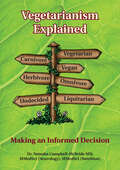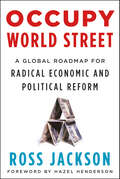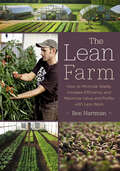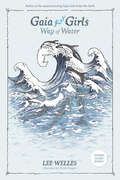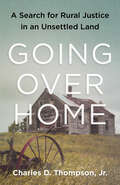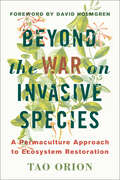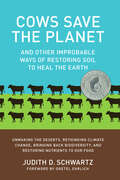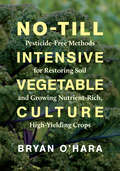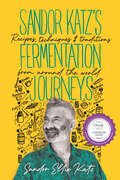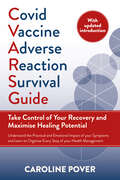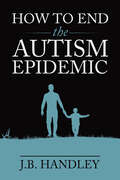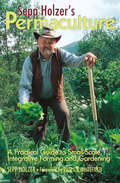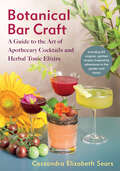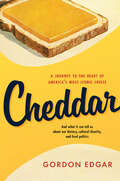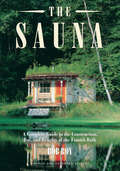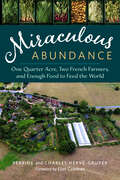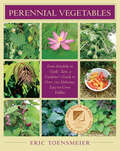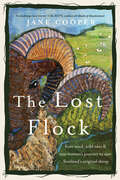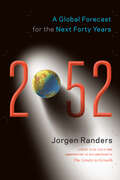- Table View
- List View
Vegetarianism Explained: Making an Informed Decision
by Natasha Campbell-Mcbride MD"Finally, a world-class human digestion expert explains why eating animals is positive for human health."--Joel Salatin, author of Your Successful Farm Business and co-author of Beyond Labels, and Polyface DesignsAnother blockbuster from Dr. Natasha Campbell-McBride, the creator and author of the GAPS Protocol—Gut And Psychology / Gut And Physiology Syndrome. Her GAPS Nutritional Protocol has been used successfully by hundreds of thousands of people around the world for treating a plethora of chronic health problems, from mental illness to physical disorders. Her book Gut and Psychology Syndrome has been translated into sixteen languages. She has now undertaken an intense study into the value of plant foods versus animal foods. Vegetarianism Explained: Making an Informed Decision is the result of this study. Dr Campbell-McBride gives a full scientific description of how animal and plant foods are digested and used by the human body. This information will give the reader a good understanding on how to feed their body to achieve optimal health and vitality.This book is an essential read for those who are considering a plant-based lifestyle and those who are already following a vegetarian or a vegan diet. The subject of fasting is covered and will give the reader a good understanding on how to use this method for healing and health. This book will also answer questions on where our food comes from and how it is produced, how to eat in harmony with your body&’s needs and how we should introduce small children to the world of food.Dr Natasha Campbell-McBride is known for her ability to explain complex scientific concepts in a language easily understood by all. Vegetarianism Explained will be enjoyed by all ages of adults – from young teenagers to mature professionals. For those who are scientifically minded the book is fully referenced.
Occupy World Street: A Global Roadmap for Radical Economic and Political Reform
by Ross JacksonOrdinary citizens the world over have long paid the price for the swashbuckling behavior of the corporate and political elite. We've seen the reigning establishment widen the gap between rich and poor, champion endless growth on a finite planet, wreak havoc on developing nations, and ravage ecosystems in a mad race for natural resources.Now, as demonstrators worldwide demand change, Occupy World Street offers a sweeping vision of how to reform our global economic and political structures, break away from empire, and build a world of self-determining sovereign states that respect the need for ecological sustainability and uphold human rights.In this refreshingly detailed plan, Ross Jackson shows how a handful of small nations could take on a leadership role; create new alliances, new governance, and new global institutions; and, in cooperation with grassroots activists, pave the way for other nations to follow suit.
The Lean Farm: How to Minimize Waste, Increase Efficiency, and Maximize Value and Profits with Less Work
by Ben HartmanA practical, systems-based approach for a more sustainable farming operation&“Ben Hartman has revolutionized his methods, cut down his work hours dramatically, and shrunk the size of his farm, all while making a better income.&”—Civil EatsTo many people today, using the words &“factory&” and &“farm&” in the same sentence is nothing short of sacrilege. In many cases, though, the same sound business practices apply whether you are producing cars or carrots. Author Ben Hartman and other young farmers are increasingly finding that incorporating the best new ideas from business into their farming can drastically cut their wastes and increase their profits, making their farms more environmentally and economically sustainable. By explaining the lean system for identifying and eliminating waste and introducing efficiency in every aspect of the farm operation, The Lean Farm makes the case that small-scale farming can be an attractive career option for young people who are interested in growing food for their community.Working smarter, not harder, also prevents the kind of burnout that start-up farmers often encounter in the face of long, hard, backbreaking labor.Lean principles grew out of the Japanese automotive industry, but they are now being followed on progressive farms around the world. Using examples from his own family&’s one-acre community-supported farm in Indiana, Hartman clearly instructs other small farmers in how to incorporate lean practices in each step of their production chain, from starting a farm and harvesting crops to training employees and selling goods.Inside The Lean Farm you&’ll discover how to apply lean practices like:Every Tool In Its PlaceTen Types of Farm WasteEstablish Pull, Don&’t PushLimits of LeanLean for More Profitand much more!While the intended audience for this book is small-scale farmers who are part of the growing local food movement, Hartman&’s prescriptions for high-value, low-cost production apply to farms and businesses of almost any size or scale that hope to harness the power of lean in their production processes.Ben Hartman was named a &“Grist 50! Fixer&”&“The Lean Farm should be dissected, digested, and discussed—then applied—on every single farm: big or small, wholesale or retail, livestock or produce. It would make all farms more profitable, productive, and pleasurable.&”—Joel Salatin, owner of Polyface Farm
Gaia Girls Way of Water
by Lee WellesMiho's backyard had always been the sea. The creatures within it were an endless source of fascination. But when the sea steals away her small family, she finds herself the ward of an uncle she has never met and submerged in a world she has never known: Japan.From the city of Nagoya to the seaside town of Goza, Miho struggles to fit in and navigate the language, the culture and her own grief. It is in Goza that she discovers her surprising family history and finds new teachers. She is befriended by an old man who becomes her Sensei and teaches her Sho-do, The Way of the Brush. And it is there she meets Gaia, the living entity of the Earth. Gaia grants her amazing powers to connect with the "minds in the water" and Miho is given access and understanding to all the world's oceans. Will she be able to use her powers to help balance the traditions of the past with the demands of the present? Can she overcome her outsider status to help others understand The Way of Water?
Going Over Home: A Search for Rural Justice in an Unsettled Land
by Jr., Charles Thompson"Going Over Home is a call that inspires the reader to stand shoulder to shoulder with family farmers in their daily struggle."—Willie NelsonAn intimate portrait of the joys and hardships of rural life, as one man searches for community, equality, and tradition in AppalachiaCharles D. Thompson, Jr. was born in southwestern Virginia into an extended family of small farmers. Yet as he came of age he witnessed the demise of every farm in his family. Over the course of his own life of farming, rural education, organizing, and activism, the stories of his home place have been his constant inspiration, helping him identify with the losses of others and to fight against injustices. In Going Over Home, Thompson shares revelations and reflections, from cattle auctions with his grandfather to community gardens in the coal camps of eastern Kentucky, racial disparities of white and Black landownership in the South to recent work with migrant farm workers from Latin America. In this heartfelt first-person narrative, Thompson unpacks our country&’s agricultural myths and addresses the history of racism and wealth inequality and how they have come to bear on our nation&’s rural places and their people.Booklist Editors&’ Choice &“Best Books of 2019&”
The New Cider Maker's Handbook: A Comprehensive Guide for Craft Producers
by Claude Jolicoeur&“I&’ve caught the cider bug, and I&’ve caught it bad. You too? Then seek out this book without delay. The New Cider Maker&’s Handbook is like having all your birthdays come at once for hard cider geeks like us. From the choosing the right apples and building your own cider press to measuring cider&’s alcohol content and adjusting the final sweetness, it&’s all right here.&”—The KitchnAll around the world, the public&’s taste for fermented cider has been growing more rapidly than at any time in the past 150 years. And with the growing interest in locally grown and artisanal foods, many new cideries are springing up all over North America, often started up by passionate amateurs who want to take their cider to the next level as small-scale craft producers.To make the very best cider—whether for yourself, your family, and friends or for market—you first need a deep understanding of the processes involved, and the art and science behind them. Fortunately, The New Cider Maker&’s Handbook is here to help. Author Claude Jolicoeur is an internationally known, award-winning cider maker with an inquiring, scientific mind. His book combines the best of traditional knowledge and techniques with up-to-date, scientifically based practices to provide today&’s cider makers with all the tools they need to produce high-quality ciders.The New Cider Maker&’s Handbook is divided into five parts containing:An accessible overview of the cider making process for beginners;Recommendations for selecting and growing cider-appropriate apples;Information on juice-extraction equipment and directions on how to build your own grater mill and cider press;A discussion of the most important components of apple juice and how these may influence the quality of the cider;An examination of the fermentation process and a description of methods used to produce either dry or naturally sweet cider, still or sparkling cider, and even ice cider.This book will appeal to both serious amateurs and professional cider makers who want to increase their knowledge, as well as to orchardists who want to grow cider apples for local or regional producers. Novices will appreciate the overview of the cider-making process, and, as they develop skills and confidence, the more in-depth technical information will serve as an invaluable reference that will be consulted again and again. This book is sure to become the definitive modern work on cider making.A mechanical engineer by profession, Claude Jolicoeur first developed his passion for apples and cider after acquiring a piece of land on which there were four rows of old abandoned apple trees. He started making cider in 1988 using a &“no-compromise&” approach, stubbornly searching for the highest possible quality. Since then, his ciders have earned many awards and medals at competitions, including a Best of Show at the prestigious Great Lakes International Cider and Perry Competition (GLINTCAP).Claude actively participates in discussions on forums like the Cider Digest, and is regularly invited as a guest speaker to events such as the annual Cider Days festival in western Massachusetts. He lives in Quebec City.
Beyond the War on Invasive Species: A Permaculture Approach to Ecosystem Restoration
by Tao OrionInvasive species are everywhere, from forests and prairies to mountaintops and river mouths. Their rampant nature and sheer numbers appear to overtake fragile native species and forever change the ecosystems that they depend on.Concerns that invasive species represent significant threats to global biodiversity and ecological integrity permeate conversations from schoolrooms to board rooms, and concerned citizens grapple with how to rapidly and efficiently manage their populations. These worries have culminated in an ongoing &“war on invasive species,&” where the arsenal is stocked with bulldozers, chainsaws, and herbicides put to the task of their immediate eradication. In Hawaii, mangrove trees (Avicennia spp.) are sprayed with glyphosate and left to decompose on the sandy shorelines where they grow, and in Washington, helicopters apply the herbicide Imazapyr to smooth cordgrass (Spartina alterniflora) growing in estuaries. The &“war on invasive species&” is in full swing, but given the scope of such potentially dangerous and ecologically degrading eradication practices, it is necessary to question the very nature of the battle. Beyond the War on Invasive Species offers a much-needed alternative perspective on invasive species and the best practices for their management based on a holistic, permaculture-inspired framework. Utilizing the latest research and thinking on the changing nature of ecological systems, Beyond the War on Invasive Species closely examines the factors that are largely missing from the common conceptions of invasive species, including how the colliding effects of climate change, habitat destruction, and changes in land use and management contribute to their proliferation.There is more to the story of invasive species than is commonly conceived, and Beyond the War on Invasive Species offers ways of understanding their presence and ecosystem effects in order to make more ecologically responsible choices in land restoration and biodiversity conservation that address the root of the invasion phenomenon. The choices we make on a daily basis—the ways we procure food, shelter, water, medicine, and transportation—are the major drivers of contemporary changes in ecosystem structure and function; therefore, deep and long-lasting ecological restoration outcomes will come not just from eliminating invasive species, but through conscientious redesign of these production systems.&“Beyond the War on Invasive Species is a devastating exposé of the military industrial invasive species complex and a sorely needed and impeccably researched volume that should become one of many as we recover from self-destructive attempts to eradicate parts of nature instead of acting with an understanding of the whole.&”—Ben Falk, author of The Resilient Farm and Homestead and founder of Whole Systems Design
Cows Save the Planet: And Other Improbable Ways of Restoring Soil to Heal the Earth
by Judith D. SchwartzIn Cows Save the Planet, journalist Judith D. Schwartz looks at soil as a crucible for our many overlapping environmental, economic, and social crises.Schwartz reveals that for many of these problems—climate change, desertification, biodiversity loss, droughts, floods, wildfires, rural poverty, malnutrition, and obesity—there are positive, alternative scenarios to the degradation and devastation we face. In each case, our ability to turn these crises into opportunities depends on how we treat the soil.Drawing on the work of thinkers and doers, renegade scientists and institutional whistleblowers from around the world, Schwartz challenges much of the conventional thinking about global warming and other problems. For example, land can suffer from undergrazing as well as overgrazing, since certain landscapes, such as grasslands, require the disturbance from livestock to thrive. Regarding climate, when we focus on carbon dioxide, we neglect the central role of water in soil—&”green water&”—in temperature regulation. And much of the carbon dioxide that burdens the atmosphere is not the result of fuel emissions, but from agriculture; returning carbon to the soil not only reduces carbon dioxide levels but also enhances soil fertility.Cows Save the Planet is at once a primer on soil&’s pivotal role in our ecology and economy, a call to action, and an antidote to the despair that environmental news so often leaves us with.&“Judith Schwartz takes a fascinating look at the world right beneath our feet. Cows Save the Planet is a surprising, informative, and ultimately hopeful book.&”—Elizabeth Kolbert, Pulitzer Prize-winning author of The Sixth Extinction
No-Till Intensive Vegetable Culture: Pesticide-Free Methods for Restoring Soil and Growing Nutrient-Rich, High-Yielding Crops
by Bryan O'HaraFrom a veteran organic grower: a unique agricultural methodology that delivers higher yields, higher quality, and higher profitability—absolutely free of herbicides or pesticidesNo-till farming has rapidly grown in popularity among vegetable growers due to its high-quality, high-yield, high-profit results. Renowned organic grower Bryan O&’Hara perfected the technique during the multi-year transition of his Connecticut vegetable farm to a no-till system. His vibrantly healthy, resilient plants are testaments to the value of allowing the inherent biological functions in soil to do their work.In No-Till Intensive Vegetable Culture, O&’Hara describes the methods he has developed, which are completely free of herbicides or other pesticides and require only a few acres of land and minimal capital investment. He asserts that this flexible, ecological methodology is as important for soil fertility as it is for his economic success. This comprehensive manual delves into all facets of a dynamic, holistic growing system, including:No-till bed preparation techniquesSeeding and transplanting methodsIrrigationUse of fertilizers (including foliar feeds)Composting (preparation and application)Culture of indigenous microorganisms to support soil biologyPest and disease managementYear-round growingHarvest and storage techniquesO&’Hara also explores the spiritual dimension of managing a farm ecosystem: observing the natural balance between plants, soil, air, water, and sunlight and the ways in which working to maintain that balance influences practical production decisions.Whether you&’re a high-yield producer, a homesteader, or a market gardener, No-Till Intensive Vegetable Culture is the go-to vegetable grower&’s manual for the twenty-first century. O&’Hara&’s advanced yet accessible methodology will both help you respond to natural systems and adapt to meet future challenges.&“Bryan O&’Hara takes us on a journey to create a healthy, vibrant ecosystem that generates health through the production of nutrient-dense food while also helping to build community. I highly recommend this book to all those who seek a better future for humanity.&”—Gabe Brown, rancher; author of Dirt to Soil
Sandor Katz's Fermentation Journeys: Recipes, Techniques, and Traditions from around the World
by Sandor Ellix KatzFrom James Beard Award winner and New York Times–bestselling author of The Art of Fermentation: the recipes, processes, cultural traditions, and stories from around the globe that inspire Sandor Katz and his life&’s work—a cookbook destined to become a modern classic essential for every home chef."Sandor&’s life of curiosity-filled travel and exploration elicits a sense of wonder as tastes, sights, and smells leap off the pages to ignite your imagination."—David Zilber, chef, fermenter, food scientist, and coauthor of The Noma Guide to Fermentation"Sandor Katz transposes his obsession with one of mankind&’s foundational culinary processes into a cookbook-cum-travelogue."—The New York Times"There is perhaps nobody more broadly knowledgeable and contagiously curious about the world&’s fermentation traditions than the effervescent Sandor Katz."—Civil Eats "It&’s a fantastic read for anyone."—Food52For the past two decades, fermentation expert and bestselling author Sandor Katz has traveled the world, both teaching and learning about the many fascinating and delicious techniques for fermenting foods. Wherever he&’s gone, he has gleaned valuable insights into the cultures and traditions of local and indigenous peoples, whether they make familiar ferments like sauerkraut or less common preparations like natto and koji.In his latest book, Sandor Katz&’s Fermentation Journeys, Katz takes readers along with him to revisit these special places, people, and foods.This cookbook goes far beyond mere general instructions and explores the transformative process of fermentation through:• Detailed descriptions of traditional fermentation techniques• Celebrating local customs and ceremonies that surround particular ferments• Profiles of the farmers, business owners, and experimenters Katz has met on his journeysIt contains over 60 recipes for global ferments, including:• Chicha de jora (Ecuador)• Misa Ono&’s Shio-koji, or salt koji (Japan)• Doubanjiang (China)• Efo riro spinach stew (Nigeria)• Whole sour cabbages (Croatia)• Chucula hot chocolate (Colombia)Sandor Katz&’s Fermentation Journeys reminds us that the magical power of fermentation belongs to everyone, everywhere. Perfect for adventurous foodies, armchair travelers, and fermentation fanatics who have followed Katz&’s work through the years—from Wild Fermentation to The Art of Fermentation to Fermentation as Metaphor—this book reflects the enduring passion and accumulated wisdom of this unique man, who is arguably the world&’s most experienced and respected advocate of all things fermented."The Godfather of the Fermentation Revival . . . [Katz is] a globe-trotting mascot for the power of bacteria and yeast to create delicious food."—GQ"This international romp is funky in the best of ways."—Publishers Weekly&“Fascinating and full of delicious stuff. . . . I&’m psyched to cook from this book.&”—Francis Lam, The Splendid Table"[Katz is] rock in the fermentation world and a true inspiration of mine . . . making fermentation approachable and fun (as it should be)."—Brad Leone, Bon AppétitMore Praise for Sandor Katz:"His teachings and writings on fermentation have changed lives around the world."—BBC&“The fermentation movement&’s guru.&”—USA Today&“A fermentation master.&”—The Wall Street Journal
Brew Beer Like a Yeti: Traditional Techniques and Recipes for Unconventional Ales, Gruits, and Other Ferments Using Minimal Hops
by Jereme Zimmerman&“Gruits and ales and beers, oh my! This book is a must-have for any ferment adventurer."–Kirsten K. Shockey, author of Fermented Vegetables and Fiery FermentsExperimentation, mystery, resourcefulness, and above all, fun—these are the hallmarks of brewing beer like a Yeti.Since the craft beer and homebrewing boom of the late twentieth and early twenty-first centuries, beer lovers have enjoyed drinking and brewing a vast array of beer styles. However, most are brewed to accentuate a single ingredient—hops—and few contain the myriad herbs and spices that were standard in beer and gruit recipes from medieval times back to ancient people&’s discovery that grain could be malted and fermented into beer.Like his first book, Make Mead Like a Viking, Jereme Zimmerman&’s Brew Beer Like a Yeti returns to ancient practices and ingredients and brings storytelling, mysticism, and folklore back to the brewing process, including a broad range of ales, gruits, bragots, and other styles that have undeservingly taken a backseat to the IPA. Recipes inspired by traditions around the globe include sahti, gotlandsdricka, oak bark and mushroom ale, wassail, pawpaw wheat, chicha de muko, and even Neolithic &“stone&” beers.More importantly, under the guidance of &“the world&’s only peace-loving, green-living Appalachian Yeti Viking,&” readers will learn about the many ways to go beyond the pale ale, utilizing alternatives to standard grains, hops, and commercial yeasts to defy the strictures of style and design their own brews.Bronze Winner—Best Book from the Beer Writers Guild
Covid Vaccine Adverse Reaction Survival Guide: Take Control of Your Recovery and Maximise Healing Potential
by Caroline PoverUnderstand the practical and emotional impact of your symptoms and learn to organize every step of your health management.If you&’re dealing with a range of complicated and confusing health problems following a Covid vaccination, this guide is for you. An adverse reaction to a Covid vaccination can be a deeply distressing experience. It may leave you mystified as you attempt to deal with a range of physical, cognitive, and psychological symptoms that few seem able to explain, diagnose, treat, or even acknowledge.The Covid Vaccine Adverse Reaction Survival Guide is here to help, taking you through this stressful experience in a way that will help you feel more in control of your life. The CVARS Guide addresses key areas of recovery to maximize your healing potential. It is also essential reading for anyone providing personal or professional support to someone who is dealing with an adverse reaction.Packed with recipes, worksheets, symptom charts, appointment records, and diary pages, the CVARS Guide demystifies nutrition plans and advice and includes ways of keeping track of symptoms so that you can tackle them without feeling overwhelmed, while you develop your own unique recovery plan.
How to End the Autism Epidemic: Revealing The Truth About Vaccines
by J.B. HandleyIn How to End the Autism Epidemic, Generation Rescue&’s co-founder J.B. Handley offers a compelling explanation of what&’s causing the autism epidemic, the lies that enable its perpetuation, and the steps we must take as parents and as a society in order to end it.While many parents have heard the rhetoric that vaccines are safe and effective and that the science is settled about the relationship between vaccines and autism, few realize that in the 1960s, American children received three vaccines compared to the thirty-eight they receive today. Or that when parents are told that the odds of an adverse reaction are &“one in a million,&” the odds are actually one in fifty. Or that in the 1980s, the rate of autism was one in ten thousand children. Today it&’s one in thirty-six.Parents, educators, and social service professionals around the country are sounding an alarm that we are in the midst of a devastating public health crisis—one that corresponds in lockstep with an ever-growing vaccine schedule. Why do our public health officials refuse to investigate this properly—or even acknowledge it?In How to End the Autism Epidemic, Handley confronts and dismantles the most common lies about vaccines and autism. He then lays out, in detail, what the truth actually is: new published science links the aluminium adjuvant used in vaccines to immune activation events in the brains of infants, triggering autism; and there is a clear legal basis for the statement that vaccines cause autism, including previously undisclosed depositions of prominent autism scientists under oath.While Handley&’s argument is unsparing, his position is ultimately moderate and constructive: we must continue to investigate the safety of vaccines, we must adopt a position of informed consent, and every individual vaccine must be considered on its own merits. This issue is far from settled. By refusing to engage with parents and other stakeholders in a meaningful way, our public health officials destroy the public trust and enable the suffering of countless children and families."[J.B. Handley] breaks down the scientific information in a way that doesn&’t intimidate the reader. And he lets us know it&’s okay to be angry. His soul, his fight, his love for his son radiates off the pages. Wow. Bravo, bravo.&”—Jenny McCarthy, author of Louder Than Words; coauthor of Healing and Preventing Autism
Sepp Holzer's Permaculture: A Practical Guide to Small-Scale, Integrative Farming and Gardening
by Sepp HolzerSepp Holzer farms steep mountainsides in Austria 1,500 meters above sea level. His farm is an intricate network of terraces, raised beds, ponds, waterways and tracks, well covered with productive fruit trees and other vegetation, with the farmhouse neatly nestling amongst them. This is in dramatic contrast to his neighbors&’ spruce monocultures.In this book, Holzer shares the skill and knowledge acquired over his lifetime. He covers every aspect of his farming methods, not just how to create a holistic system on the farm itself, but how to make a living from it. Holzer writes about everything from the overall concepts, down to the practical details. In Sepp Holzer&’s Permaculture readers will learn:How he sets up a permaculture systemThe fruit varieties he has found best for permaculture growingHow to construct terraces, ponds, and waterwaysHow to build shelters for animals and how to work with them on the landHow to cultivate edible mushrooms in the garden and on the farmand much more!Holzer offers a wealth of information for the gardener, smallholder or alternative farmer yet the book&’s greatest value is the attitudes it teaches. He reveals the thinking processes based on principles found in nature that create his productive systems. These can be applied anywhere.
Botanical Bar Craft: A Guide to the Art of Apothecary Cocktails and Herbal Tonic Elixirs
by Cassandra Elizabeth SearsFor cocktail enthusiasts, herbalists, foragers, and bartenders, Botanical Bar Craft serves up original, spirited recipes and invaluable plant knowledge, inspired by adventures in the garden and forest.In Botanical Bar Craft, innovative herbalist and mixologist Cassandra Sears invites readers to create herbal elixirs and apothecary cocktails infused by a close connection to nature. Whether in the garden, the field, or the forest, Sears finds generous abundance among the plants. Her tonic libations harness the power of phytochemistry and place-based consciousness while easing stress and comforting the body, mind, and spirit. With original recipes that tie together the creative arts of herbal medicine and craft cocktail making, Sears blends herbal tinctures, teas, and botanical infusions into modern-classic cocktails as well as sensational and unique nonalcoholic drinks that hit the spot for relaxation without sedation.More than just a collection of recipes, Botanical Bar Craft is also an herbal handbook for bartenders and a mixology guide for herbalists. Readers will delight in the journey as Sears combines dashes of herbal lore and history with instructions for developing the spirited philosophy of apothecary bartending, lessons on mixology, and a primer on the beneficial actions of medicinal herbs.Inside Botanical Bar Craft, you&’ll also find:65 original recipes for potions, tonics, elixirs, and cocktails, including Kava Cacao Flip, Pregnancy Punch, Victory Garden, Bloody Botanist, Bitters and Soda, Juice of Life, and Euphoria.More than 40 plant profiles that include how those plants grow and suggestions for how to use them behind the bar to draw out their beneficial actions.An accessible explanation of the chemistry and energetics of medicinal herbs.Behind-the-scenes interviews with artisan distillers.Advice and tips for growing a garnish garden.This book will not only appeal to herbalists, herbal enthusiasts, and home cocktail enthusiasts, but also to professional bartenders looking to embrace the use of innovative and highly flavorful natural ingredients in their bar creations. Botanical Bar Craft provides all the answers for those who are curious and wondering how to make a really good drink inspired by and infused with plants.&“Unique among cocktail books—it helps readers reconnect their creative selves with the natural environment and healing plants. . . [Sears] equips you with the proper bar techniques to harness the power and fleeting beauty of your surroundings.&”—Brian Catapang, bar director and co-owner at Magnus on Water
Pawpaw: In Search of America’s Forgotten Fruit
by Andrew MooreThe largest edible fruit native to the United States tastes like a cross between a banana and a mango. It grows wild in twenty-six states, gracing Eastern forests each fall with sweet-smelling, tropical-flavored abundance. Historically, it fed and sustained Native Americans and European explorers, presidents, and enslaved African Americans, inspiring folk songs, poetry, and scores of place names from Georgia to Illinois. Its trees are an organic grower&’s dream, requiring no pesticides or herbicides to thrive, and containing compounds that are among the most potent anticancer agents yet discovered.So why have so few people heard of the pawpaw, much less tasted one? In Pawpaw—a 2016 James Beard Foundation Award nominee in the Writing & Literature category—author Andrew Moore explores the past, present, and future of this unique fruit, traveling from the Ozarks to Monticello; canoeing the lower Mississippi in search of wild fruit; drinking pawpaw beer in Durham, North Carolina; tracking down lost cultivars in Appalachian hollers; and helping out during harvest season in a Maryland orchard. Along the way, he gathers pawpaw lore and knowledge not only from the plant breeders and horticulturists working to bring pawpaws into the mainstream (including Neal Peterson, known in pawpaw circles as the fruit&’s own &“Johnny Pawpawseed&”), but also regular folks who remember eating them in the woods as kids, but haven&’t had one in over fifty years. As much as Pawpaw is a compendium of pawpaw knowledge, it also plumbs deeper questions about American foodways—how economic, biologic, and cultural forces combine, leading us to eat what we eat, and sometimes to ignore the incredible, delicious food growing all around us. If you haven&’t yet eaten a pawpaw, this book won&’t let you rest until you do.James Beard Foundation Book Award Nominee&“This book took me on an enchanting and engaging ride through the history, folklore, and science of a neglected but magical food plant. Andrew Moore shows us, in delightful prose and a wealth of fascinating stories, the role that the under-appreciated pawpaw has played in North American culture.&”—Toby Hemenway, author of Gaia&’s Garden and The Permaculture City&“Andrew Moore takes us on a very personal journey investigating how and why North America's largest indigenous fruit largely disappeared, and documenting efforts to revive it. Pawpaw is a pleasure to read, and if you do you'll probably find yourself searching for and loving these delectable fruits.&”—Sandor Ellix Katz, author of The Art of Fermentation
Cheddar: A Journey to the Heart of Americas Most Iconic Cheese
by Gordon Edgar"Both thought-provoking and fun"—Paul Kindstedt, author of Cheese and CultureOne of the oldest, most ubiquitous, and beloved cheeses in the world, the history of cheddar is a fascinating one. Over the years it has been transformed, from a painstakingly handmade wheel to a rindless, mass-produced block, to a liquefied and emulsified plastic mass untouched by human hands. The Henry Fordism of cheddar production in many ways anticipated the advent of industrial agriculture. They don&’t call it &“American Cheese&” for nothing.Cheddar is one man&’s picaresque journey to find out what a familiar food can tell us about ourselves. Cheddar may be appreciated in almost all American homes, but the advocates of the traditional wheel versus the processed slice often have very different ideas about food. Since cheddar—with its diversity of manufacturing processes and tastes—is such a large umbrella, it is the perfect food through which to discuss many big food issues that face our society.More than that, though, cheddar actually holds a key to understanding not only issues surrounding food politics, but also some of the ways we think of our cultural identity. Cheddar, and its offshoots, has something to tell us about this country: the way people rally to certain cheddars but not others; the way they extol or denounce the way others eat it; the role of the commodification of a once-artisan cheese and the effect that has on rural communities. The fact that cheddar is so common that it is often taken for granted means that examining it can lead us to the discovery of usually unspoken truths.Author Gordon Edgar (Cheesemonger: A Life on the Wedge) is well equipped to take readers on a tour through the world of cheddar. For more than fifteen years he has worked as an iconoclastic cheesemonger in San Francisco, but his sharp talent for observation and social critique were honed long before then, in the world of &’zines, punk rock, and progressive politics. His fresh perspectives on such a seemingly common topic are as thought provoking as they are entertaining.
The Sauna: A Complete Guide to the Construction, Use, and Benefits of the Finnish Bath, 2nd Edition
by Robert L. RoyReplete with history, tradition, health benefits, instructions for proper use and maintenance, this completely revised and expanded edition will inspire!With a history going back at least one thousand years, the sauna is ready for a new generation of enthusiasts seeking health, pleasure, and peace of mind, and Rob Roy is ready to recruit! &“If the sauna is just a bath, then Buckingham Palace is just a house.&” So writes sauna expert and intrepid do-it-yourselfer Roy in this new, updated version of The Sauna.This completely revised and expanded edition of The Sauna contains everything you ever wanted to know about the famous &“Finnish bath.&” In this inviting book, Roy shares his infectious enthusiasm for the sauna and provides a complete, detailed guide to sauna building, along with resources for equipment and supplies.The Sauna is replete with history, tradition, health benefits, instructions for proper use and maintenance, as well as step-by-step instructions for building a variety of cordwood masonry saunas and, new to this edition, conventionally wood-framed saunas. The beautiful color photographs, also new to this edition, will inspire you to create your own sauna haven.
Miraculous Abundance: One Quarter Acre, Two French Farmers, and Enough Food to Feed the World
by Perrine Herve-Gruyer Charles Herve-Gruyer&“Farmers like Charles and Perrine Hervé-Gruyer [are] beacons of light. Their work allows the rest of the world to see that there is another life, there is another way.&”—Eliot ColemanWhat began as a simple dream has turned into one of the world&’s most radical, innovative experiments in small-scale farming—using the Bec Hellouin model for growing food, sequestering carbon, creating jobs, and increasing biodiversity without using fossil fuelsWhen Charles and Perrine Hervé-Gruyer set out to create their farm in a historic Normandy village, they had no idea just how much their lives would change. Neither one had ever farmed before. Charles had been traveling the globe teaching students about ecology and indigenous cultures. Perrine had been an international lawyer in Japan. Their farm Bec Hellouin has since become an internationally celebrated model of innovation in ecological agriculture. Miraculous Abundance is the eloquent tale of the couple&’s quest to build an agricultural model that can carry us into a post-carbon future.The authors dive deeper into the various farming methods across the globe that contributed towards the creation of the Bec Hellouin model, including:Permaculture and soil health principlesKorean natural farming methodsManaging a four-season farmCreating a productive agroecosystem that is resilient and durableUsing no-dig methods for soil fertilityModelling an agrarian system that supports its community in totality; from craft, restaurants and shared work spaces to jobs, agritourism, energy and ecological biodiversityPerfect for aspiring and experienced farmers, gardeners, and homesteaders, Miraculous Abundance is a love letter to a future where ecological farming is at the centre of every community. &“This book, more about philosophy than a how-to, describes how two inexperienced beginners succeeded in creating a gorgeous, productive, self-sustaining farm.&”—Marion Nestle
Perennial Vegetables: From Artichokes to Zuiki Taro, A Gardener's Guide to Over 100 Delicious and Easy to Grow Edibles
by Eric ToensmeierForeWord Magazine Book of the Year Award: Home & GardenAmerican Horticultural Society Book Award In Perennial Vegetables the adventurous gardener will find information, tips, and sound advice on less common edibles that will make any garden a perpetual, low-maintenance source of food.Imagine growing vegetables that require just about the same amount of care as the flowers in your perennial beds and borders—no annual tilling and potting and planting. They thrive and produce abundant and nutritious crops throughout the season. It sounds too good to be true, but in Perennial Vegetables author and plant specialist Eric Toensmeier (Edible Forest Gardens) introduces gardeners to a world of little-known and wholly underappreciated plants. Ranging beyond the usual suspects (asparagus, rhubarb, and artichoke) to include such &“minor&” crops as ground cherry and ramps (both of which have found their way onto exclusive restaurant menus) and the much sought after, anti-oxidant-rich wolfberry (also known as goji berries), Toensmeier explains how to raise, tend, harvest, and cook with plants that yield great crops and satisfaction.Perennial vegetables are perfect as part of an edible landscape plan or permaculture garden. Profiling more than 100 species, illustrated with dozens of color photographs and illustrations, and filled with valuable growing tips, recipes, and resources, Perennial Vegetables is a groundbreaking and ground-healing book that will open the eyes of gardeners everywhere to the exciting world of edible perennials.
Wind Power: Renewable Energy for Home, Farm, and Business, 2nd Edition
by Paul GipeCompletely Revised and Expanded EditionWind energy today is a booming worldwide industry. The technology has truly come of age, with better, more reliable machinery and a greater understanding of how and where wind power makes sense—from the independent developer to the grid-connected utility-wide perspective. Heightened concerns about our ravaged environment and our dependence on dwindling fossil fuels have stimulated a resurgence of interest in wind energy - an abundant and renewable resource. Wind Power is a completely revised and expanded edition of Paul Gipe's definitive 1993 book Wind Power for Home and Business. In addition to expanded sections on gauging wind resources and siting wind turbines, this edition includes new examples and case studies of successful wind systems, international sources for new and used equipment, and hundreds of colour photographs and illustrations.
Eager: The Surprising, Secret Life of Beavers and Why They Matter
by Ben GoldfarbWINNER of the 2019 PEN/E.O. Wilson Literary Science Writing AwardAuthor of the New York Times 2023 &“Notable Book&” CrossingsWashington Post &“50 Notable Works of Nonfiction&”Science News &“Favorite Science Books of 2018&”Booklist &“Top Ten Science/Technology Book of 2018&”&“A marvelously humor-laced page-turner about the science of semi-aquatic rodents…. A masterpiece of a treatise on the natural world.&”—The Washington PostIn Eager, environmental journalist Ben Goldfarb reveals that our modern idea of what a healthy landscape looks like and how it functions is wrong, distorted by the fur trade that once trapped out millions of beavers from North America&’s lakes and rivers. The consequences of losing beavers were profound: streams eroded, wetlands dried up, and species from salmon to swans lost vital habitat. Today, a growing coalition of &“Beaver Believers&”—including scientists, ranchers, and passionate citizens—recognizes that ecosystems with beavers are far healthier, for humans and non-humans alike, than those without them. From the Nevada deserts to the Scottish highlands, Believers are now hard at work restoring these industrious rodents to their former haunts. Eager is a powerful story about one of the world&’s most influential species, how North America was colonized, how our landscapes have changed over the centuries, and how beavers can help us fight drought, flooding, wildfire, extinction, and the ravages of climate change. Ultimately, it&’s about how we can learn to coexist, harmoniously and even beneficially, with our fellow travelers on this planet.
The Lost Flock: Rare Wool, Wild Isles and One Woman's Journey to Save Scotland's Original Sheep
by Jane Cooper"A windswept love letter"—Cal Flyn, author of Islands of AbandonmentFrom Viking times to pastoral Highland crofts to odious research experiments, this is the untold, real-life detective story of the remarkable little horned sheep known as the Orkney Boreray and the determined woman who moved to one of Scotland's wildest islands to save them.It was Jane Cooper&’s passion for knitting that led her to search for rare-breed sheep and their distinctive wool. When she found a &‘lost flock&’ of Boreray sheep—the UK&’s rarest breed of sheep—it ignited a quest that would ultimately change her life. Uprooting her suburban existence in Newcastle, she embarked on a new adventure as a farmer and shepherd in the faraway Orkney Islands.There, to her astonishment, Jane realized that she was the sole custodian of the last remnants of a unique group of Boreray sheep, what then became her Orkney Boreray flock. She began investigating its mysterious and ancient history, tracking down the origins of the breed, its significance to Scotland&’s natural heritage, and the importance of protecting the Orkney Boreray from extinction."Jane Cooper combines intelligence, heart and passion to create a life of integrity not only for herself but for one of the rarest breeds of sheep on the planet. . . . Her trials and triumphs offer a stellar example for others to follow in their own ways. Bravo!"—Deborah Robson, author of The Fleece and Fiber Sourcebook
Fresh Food from Small Spaces: The Square-Inch Gardener's Guide to Year-Round Growing, Fermenting, and Sprouting
by R.J. RuppenthalBooks on container gardening have been wildly popular with urban and suburban readers, but until now, there has been no comprehensive "how-to" guide for growing fresh food in the absence of open land. Fresh Food from Small Spaces fills the gap as a practical, comprehensive, and downright fun guide to growing food in small spaces. It provides readers with the knowledge and skills necessary to produce their own fresh vegetables, mushrooms, sprouts, and fermented foods as well as to raise bees and chickens—all without reliance on energy-intensive systems like indoor lighting and hydroponics.Readers will learn how to transform their balconies and windowsills into productive vegetable gardens, their countertops and storage lockers into commercial-quality sprout and mushroom farms, and their outside nooks and crannies into whatever they can imagine, including sustainable nurseries for honeybees and chickens. Free space for the city gardener might be no more than a cramped patio, balcony, rooftop, windowsill, hanging rafter, dark cabinet, garage, or storage area, but no space is too small or too dark to raise food.With this book as a guide, people living in apartments, condominiums, townhouses, and single-family homes will be able to grow up to 20 percent of their own fresh food using a combination of traditional gardening methods and space-saving techniques such as reflected lighting and container "terracing." Those with access to yards can produce even more.Author R. J. Ruppenthal worked on an organic vegetable farm in his youth, but his expertise in urban and indoor gardening has been hard-won through years of trial-and-error experience. In the small city homes where he has lived, often with no more than a balcony, windowsill, and countertop for gardening, Ruppenthal and his family have been able to eat at least some homegrown food 365 days per year. In an era of declining resources and environmental disruption, Ruppenthal shows that even urban dwellers can contribute to a rebirth of local, fresh foods.
2052: A Global Forecast for the Next Forty Years
by Jorgen RandersWith clarity, conscience, and courage, global-systems pioneer Jorgen Randers and his distinguished contributors map the forces that will shape the next four decades.Forty years ago, The Limits to Growth study addressed the grand question of how humans would adapt to the physical limitations of planet Earth. It predicted that during the first half of the 21st century the ongoing growth in the human ecological footprint would stop-either through catastrophic "overshoot and collapse"-or through well-managed "peak and decline."So, where are we now? And what does our future look like? In the book 2052, Jorgen Randers, one of the coauthors of Limits to Growth, issues a progress report and makes a forecast for the next forty years. To do this, he asked dozens of experts to weigh in with their best predictions on how our economies, energy supplies, natural resources, climate, food, fisheries, militaries, political divisions, cities, psyches, and more will take shape in the coming decades. He then synthesized those scenarios into a global forecast of life as we will most likely know it in the years ahead.The good news: we will see impressive advances in resource efficiency, and an increasing focus on human well-being rather than on per capita income growth. But this change might not come as we expect. Future growth in population and GDP, for instance, will be constrained in surprising ways-by rapid fertility decline as result of increased urbanization, productivity decline as a result of social unrest, and continuing poverty among the poorest 2 billion world citizens. Runaway global warming, too, is likely.So, how do we prepare for the years ahead? With heart, fact, and wisdom, Randers guides us along a realistic path into the future and discusses what readers can do to ensure a better life for themselves and their children during the increasing turmoil of the next forty years.
